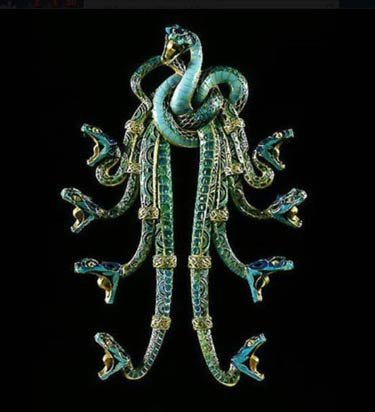
René Lalique, Serpents brooch, 1898-1899.
One of my European Facebook friends forwarded a photo of the above piece of jewelry, which I, at least, failed to recognize as Lalique.
My curiosity is strong, so I captured the picture and ran it through a search program (Tineye), thereby identifying its source as Odisea2008.com, a Spanish-language web-site regularly purveying images of art.
(I never actually studied Spanish, but for the convenience of my Anglophone readers, I have combined my own feeble efforts with Google translator to produce a readable (reasonably accurate, I hope) version of Odisea2008’s accompanying text.)
RENÉ LALIQUE, AN ARTISTIC GENIUS
René Lalique was born in 1860 and died in 1945, and lived two successive artistic lives, as he expressed different facets of his personality in two diametrically opposed styles: the Art Nouveau and the later Art Deco.
Basing his inspiration on nature and having had the audacity (for the time) to use the female body as an element of ornamentation, Lalique created some of the most representative jewelry of the Art Nouveau style. His earrings, brooches, tiaras, glasses, combs were original and imaginative works using the most elaborate techniques. He was not afraid to use previously little-used materials, such as horn, ivory, semi-precious stones, enamel and inlaid glass that was combined with gold and precious stones. His originality and talent caused him to be regarded by Emile Gallé as the inventor of modern jewelry.
At the height of his career as a jeweler, Lalique gradually changed direction and became a glazier. His earliest experiments dated back to the 1890s, but his encounter with the perfumer François Coty in 1908 played a decisive role, causing him not only to create produce bottles for the greatest perfumers, but gradually also to add to his productions, boxes, vases, lamps, and so on.
His reputation in the realm of glass was such that his factory at Combs-la-Ville, could not meet the demand, so after the World War, Lalique opened a second manufactury in Alsace at Wingen-sur-Moder, knowing that he could find in this region with a tradition of stained glass production the necessary skilled labor and that he would be able to obtain support from the government which at that time was seeking to establish the region of Alsace and Moselle as “the glass-center of France.”
Glazier of genius and eclectic creator, Lalique was not only interested in the arts of tableware and perfume bottles. He also produced, in the luxury years of the 1920s, equally emblematic designs for car radiator mascots, lighting for trains like the Orient-Express, for passenger ships like the Normandie, and for luxury stores. Lalique also took a special interest in religious architecture for which he produced some extraordinary designs.
After the death of Rene Lalique in 1945, his son Marc succeeded him in directing the company. Imbued with the same passion for the work, he used his technical skills to rebuild and modernize the factory largely destroyed during the war. Abandoning glass in favor of crystal, He exploited the contrast between the transparent and the satin-glazed to achieve the maximum expressivity from this pure material. It was this particular effect which became famous worldwide and was recognized as characterizing the brand “Lalique”. Under his guidance, the company quickly reached the highest position among the great French and foreign glassmakers.
Marie-Claude succeeded her father Marc in 1977, with the intention of combining tradition and renewal, along with the love of natural forms and the capability of reproducing and communicating their essence in objects, that for three generations has marked the creative sensibility of Lalique.
In 2008, the Lalique Company was merged into the Pochet Group of Art and Fragrance Companies and Saint-Germain Finance. The aim of its president and CEO, Silvio Denz is to strengthen the brand name in the world market and to increase its production capacity of glassware. Collections of jewelry and perfume bottles continue to be developed in parallel with traditional stained glass activity. Reissues of old works and contemporary creations are still produced in Wingen-sur-Moder by master glassmakers, where several of the best workers in France perpetuate the cult of excellence.








